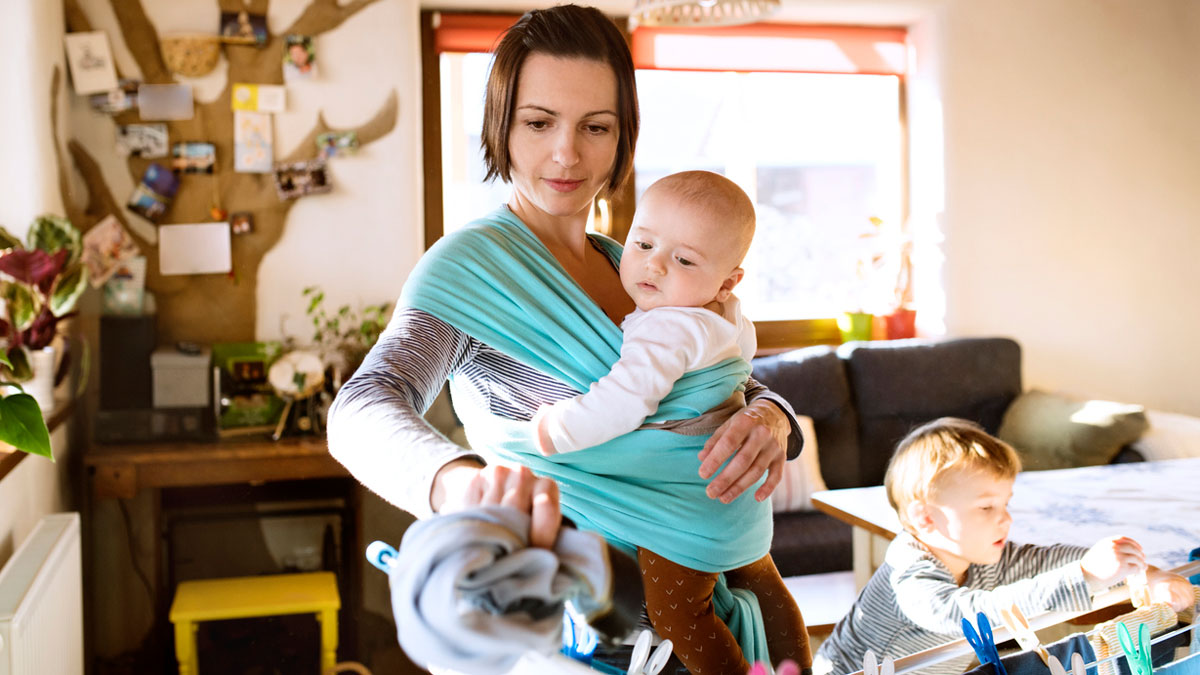My name is Eliza, and I was an attachment parent. I wore flowy pants, nursing tanks, and pendants that doubled as teething toys. My amber-necklaced children ate organic bean sticks while wrapped to my back, and I didn’t breastfeed in public—I whipped out my boob in defiance of the patriarchy. My children wore disposable diapers once in their lives and co-slept until age four. I thought C-sections and strollers were sadz.
This had nothing to do with “attachment parenting” and everything to do with my own identity crisis. I was an “attachment parent” who merged choices with a philosophy and fashion aesthetic.
Real talk: attachment parenting is a style of parenting that prioritizes a child’s need for connection. Its central tenets include breastfeeding on demand (if possible), babywearing (if possible), and co-sleeping (if it’s done safely). Those are hugely taxing, especially for the child’s mother, who sacrifices her body, sleep cycles, and spare time for her child. It might pay off in the long run, depending on who you ask. But it’s intense.
For a variety of reasons, it worked well for us. I was obnoxious but happy; my children are well-adjusted little people who know my husband and I will always be there for them. They tend toward more independence, not less. But for years, I was a feminist’s nightmare. Breastfeeding on demand, babywearing, and co-sleeping require constant physical contact with another human being. I left my children with only a few trusted people, and very seldomly, so my husband and I never went out alone.
If parenting is hard, attachment parenting can, by nature, make it harder—or easier. I honestly didn’t mind the constant cling. I rarely became “touched out” and I liked to cuddle. Bottles and formula sounded high maintenance—no freaking way was I waking up at 2 a.m. to mix one. In fact, no freaking way was I waking up at 2 a.m. I stirred, latched on a baby, and fell asleep again (we followed these safe co-sleeping guidelines). Those baby carrier-car seat things looked like a chiropractic nightmare, and I loved wearing my kids. We took them everywhere, from nice restaurants to art museums. Other than that endless contact, it gave us far more freedom: no car seat to lug, no formula to mess with, and intermittent rather than constant sleep deprivation.
However, attachment parenting can be draining, primarily for the mother. By virtue of these parenting choices, her emotional priority becomes the child, not herself or her spouse. (Friends have lamented to me that they didn’t poop alone for years.) This can alienate partners, friends, and family members. Spouses might resent the neverending physical and emotional barrier a baby creates. Friends may find it difficult to relate to someone who spends most of their time wrapped up in an infant.
Other people can find these choices difficult, too. There’s tremendous social pressure to parent like everyone else. People harass you for breastfeeding in public. Strangers try to help you wrap your baby on your back, or inform you that babywearing’s dangerous. Talk about co-sleeping brings up horror stories; people assume you’re irresponsible. You’re often arguing from the very beginning. Postpartum nurses try to take your child for an exam. You’re given formula samples. You’re banned from co-sleeping until discharge—not only is it hospital policy, but the bed makes it dangerous.
When you’re constantly defending your choices, you begin to resent it, and the truth is, society isn’t supportive of attachment parenting. This can lead to an us-against-the-world mindset, which isn’t conducive to parenting in any form. It often creates an echo chamber of like-minded friends, too. When our children were babies, I rarely hung out with one of my dear friends, though our sons were only a month apart. We parented differently, and it was hard for both of us to see past that.
Attachment parenting was just intuitive for us. My husband and I always seem to feel far less stressed than our friends and relatives who used traditional parenting techniques. Our children certainly cried less—easier on the ears, but perhaps more about boob proximity than happiness. And while many skeptics insist that children whose needs are “catered to” will become dependent, we’ve found the opposite. My sons are independent little risk-takers, disciplined and considerate. I think much of that comes from baby- and toddlerhoods in which their needs were met (not catered to, thanks) and their desire for connection satisfied.
But just because it worked for me does not mean it will work for you. My husband and I loved it; you might rather chew glass than keep a child attached to you 24/7. I certainly fell into the attachment-parent-as-identity trap, and many would view my postpartum life as an oppressive hellscape. It didn’t seem that way. I made choices that felt right to me.
That’s why you practice attachment parenting, in the end: if it feels right and makes you happy, do it. If it seems like too much or makes you unhappy, stop. No matter what people tell you, never prioritize your child’s emotional health over your own, if only because an unhappy parent creates an unhappy child. My children have so far grown up happy and kind, and I think attachment parenting helped them get there.
But it’s not the only way there. Don’t let anyone tell you differently.
